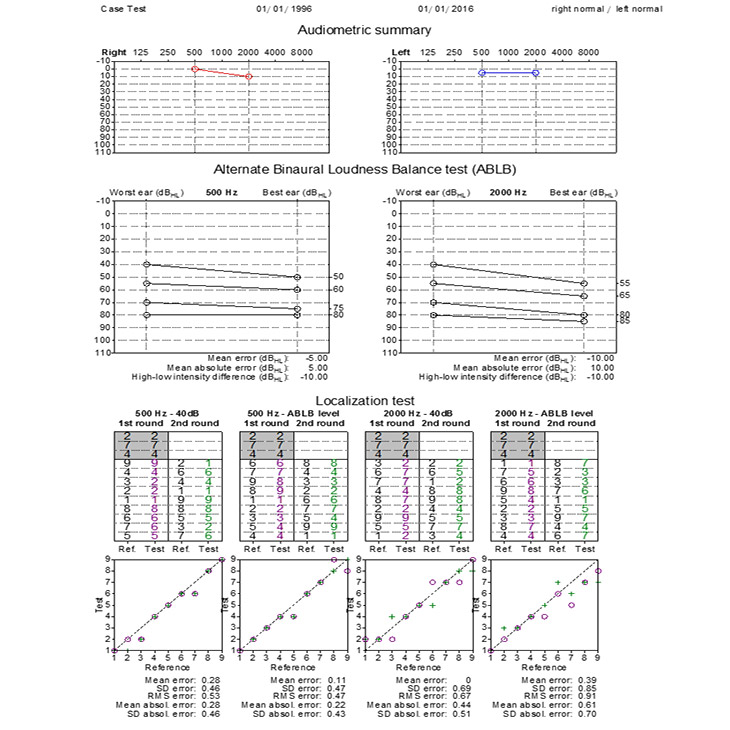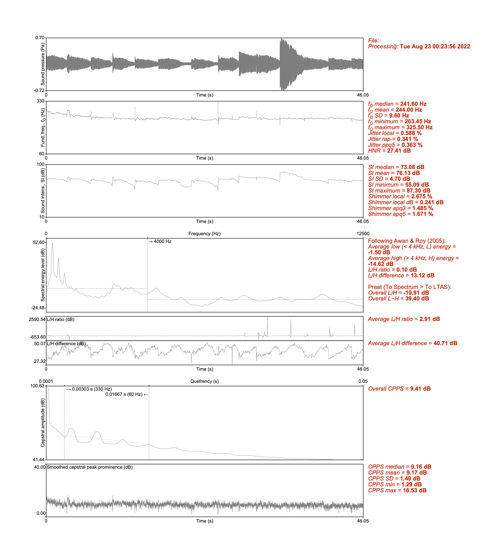With the program Praat it is possible to develop/design all kinds of (audio and other) signal processing methods or even data management protocols.
- Maryn et al. (2017) applied a data management protocol in the program Praat for automatic retrieval, editing, analysis and data saving of 3000 voice recordings. This enabled standardized and efficient data management, which was a major concern for such an elaborate study.
- For De Coninck et al. (2016), a Praat routine was custom-made to automate (a) assignment of a subject to a group (normal hearing or hearing impaired), (b) completion of their hearing thresholds at 0.5 and 4 kHz, (c) completion of their Alternate Binaural Loudness Balance (ABLB) test results and calculation of relevant errors and difference also at 0.5 and 4 kHz, and (d) completion of their auditory localization test results and calculation of relevant errors in localization (see Figure 1).
Regarding signal processing, all the measurement scripts available at PHONANIUM’s website are examples of digital audio signal processing methods for clinical purposes. However, many other clinical scripts have been developed and applied as well. Here are some examples.
- In a preliminary norm-referencing study using the program Praat, Standaert et al. (2013) implemented multiple scripts to automatically determine parameters related to vowel discrimination (i.e., vowel triangl geometry; see Figure 2 for an example), speech diadochokinesis, voiceless fricative differentiation, speech prosody, syllabic speech rate and vowel nasalization.
- Upon request from Dr. Adrianna Shembel (PhD, CCC-SLP) from the Integrative Laryngeal BioPhysiology Lab at the University of Texas (UT Southwestern), a tool was developed in 2022 to automatically process acoustic voice/speech signals in batch. This custom-made script enabled her and her lab’s staff to determine various time-, frequency- and quefrency-domain markers of a large number of voice samples in a single operation. Some examples of acoustic markers are: median fundamental frequency, low frequency energy versus high frequency energy (L/H ratio), and standard deviation in smoothed cepstral peak prominence (CPPS-SD). All measurements are stored in a spreadsheet and can easily be consulted and used for statistical and other analyses. Furthermore, a PDF of the graphical output (Figure 3) is saved for every voice sample. Such a batch processing tool permits fast, reliable and efficient data analysis. Especially is research projects this may be very practical.
It is clear that scripts in the program Praat are ideal for automating data management and digital signal processing (or a combination of them both) in voice/speech/hearing sciences and clinics. Are you a student working on a thesis, a researcher studying specific phenomena, or a clinician wanting to measure particular behaviors? Regardless of your background or the scope and depth of your project, maybe PHONANIUM can help you to achieve your goal by providing or customizing a script, or by writing a de novo script. If you have a question or a project you like to consult PHONANIUM for, just complete the form below. Please provide as much as possible information so we can appropriately address your question(s). Because of specificity, however, each project or question requires its own customized development or answer, respectively, and every cooperation is unique. It is therefore too difficult to provide standard terms/conditions. After receipt of your completed form, we will start defining our mutual cooperation (if within our possibilities) as well as the conditions.





